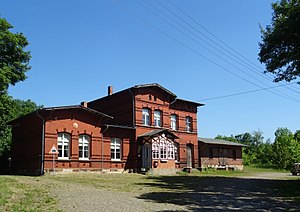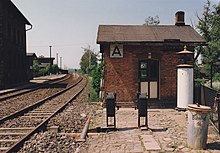Jerxheim – Nienhagen railway line
| Jerxheim – Nienhagen | |||||||||||||||||||||||||||||||||||||||||||||||||||||||||||||||||||||
|---|---|---|---|---|---|---|---|---|---|---|---|---|---|---|---|---|---|---|---|---|---|---|---|---|---|---|---|---|---|---|---|---|---|---|---|---|---|---|---|---|---|---|---|---|---|---|---|---|---|---|---|---|---|---|---|---|---|---|---|---|---|---|---|---|---|---|---|---|---|
|
Dedeleben station was the
terminus of the operated line for 55 years . | |||||||||||||||||||||||||||||||||||||||||||||||||||||||||||||||||||||
| Route number (DB) : | 1943 | ||||||||||||||||||||||||||||||||||||||||||||||||||||||||||||||||||||
| Course book section (DB) : | 319 (2001) | ||||||||||||||||||||||||||||||||||||||||||||||||||||||||||||||||||||
| Route length: | 32.9 km | ||||||||||||||||||||||||||||||||||||||||||||||||||||||||||||||||||||
| Gauge : | 1435 mm ( standard gauge ) | ||||||||||||||||||||||||||||||||||||||||||||||||||||||||||||||||||||
|
|||||||||||||||||||||||||||||||||||||||||||||||||||||||||||||||||||||
The Jerxheim – Nienhagen line was a branch line in (today's) south-eastern Lower Saxony and in western Saxony-Anhalt . It was also commonly called the Huy Railway . The Huy is a ridge near the route.
Route description
About one kilometer after Jerxheim, the route crossed the border between today's federal states of Lower Saxony and Saxony-Anhalt and thus the former inner-German border . After five kilometers in a southerly direction, the long-standing Dedeleben terminus was reached. For a long time, a sugar factory provided goods traffic there. In Badersleben , the route bent at a right angle to the east and ran parallel to the Huy for around 15 kilometers . From Anderbeck a branch line led south to the Huy until 1974. Before and after Schwanebeck , the track again had 90-degree bends. In Nienhagen , the main line Magdeburg – Halberstadt and the Aschersleben – Nienhagen line were reached.
history
Construction and planning
The main reason for the construction was the planned removal of salts supported by the Wilhelmshall union , the cement works in Schwanebeck and the surrounding sugar factories . This was preceded by the end of the state salt monopoly in Prussia in 1868 , which caused a considerable boom in this branch. The winding route reflected this, as as many places as possible were to be connected. The railway line went into operation on August 15, 1890.
The time until 1945
In 1891 the connecting line from Anderbeck to the potash mine on the north side of the Huy was opened. In 1907 the cement works near Schwanebeck was connected to the Jerxheim – Nienhagen railway line by a 750 mm track . A field railway with a gauge of 600 millimeters led from the cement works to a quarry, which supplied the works with lime .
In 1914 there were considerations to build a route Oschersleben (Bode) –Dedeleben– Heudeber-Danstedt with a branch line Dedeleben– Schlanstedt . The main initiator was the Schlanstedter Saatzucht of the entrepreneur Strube. The beginning of the war prevented this project and a 600 mm field railway, the Strube Railway , was built from Eilenstedt station to Schlanstedt.
Passenger traffic on the Jerxheim – Nienhagen route played a subordinate role right from the start. Most of the passengers were commuters to the industrial plants on the route. Salt mining was given up as early as 1926. The specially built connecting line from Anderbeck to Wilhelmshall, however, was retained and was reactivated by the Wehrmacht in 1934 . In the shafts of the mine, the army ammunition facility Dingelstedt b. Halberstadt , "Muna" for short, set up. In 1944 around 600 employees and forced laborers were busy producing ammunition , which was driven off via the connecting route. The 1944 timetable lists five pairs of passenger trains a day, the trains went to Halberstadt. On September 21, 1944, there were two explosions with 59 dead, one of which was triggered by ammunition in a freight car. In 1945 production came to a standstill due to the end of World War II.
The operation on the section from Jerxheim – Dedeleben was interrupted due to the establishment of the inner-German border, the line was dismantled. From then on there was only rail traffic on the Dedeleben – Nienhagen section.
The time after 1945
The connection route to the former ammunition plant was still used for the handling of goods from neighboring companies. After it became clear that restarting the potash mine was unprofitable, this line was dismantled in 1974.
The field railway to Schlanstedt had already been shut down in 1969. A field railway museum still exists there today.
The Schwanebeck cement works remained connected to the route network for a longer period of time. In 1951 a new, standard-gauge connecting line was put into operation between the station and the cement works. A new 900-millimeter track was also laid to the quarry, so that a three -rail track was partially created there.
First decommissioning efforts
Already at the beginning of the 1970s there were first attempts to close the Dedeleben – Nienhagen line because the superstructure was in poor condition. However, a complete renovation took place again, especially in the summer of 1974. However, the concrete sleepers installed here showed severe alkali damage after a few years . The route could only be kept in a passable condition with great effort. In the winter of 1975/76 seven pairs of passenger trains ran the route every day. All trains were tied to and from Halberstadt . In 1989 there were eight pairs of trains on weekdays and five on Sundays.
The end
As a result of the fall of the Wall , freight traffic and thus the livelihood of this connection largely collapsed. Passenger traffic suffered similar losses. That is why the first rationalizations took place in 1990. In 1992 one of the main goods customers, the Schwanebeck cement works, ceased production. The grain trains from Badersleben that had been in service until then were also discontinued. As a result, freight traffic between Schwanebeck and Dedeleben was discontinued on May 22, 1993, and on the Nienhagen – Schwanebeck route on June 1, 1997. In the last few years of its existence, passenger traffic was carried out with series 771 and 772 rail buses . There were also further defects in the superstructure. Last weekdays five pairs of trains ran between Nienhagen and Dedeleben, and another between Nienhagen and Dingelstedt. Only one was tied through to Halberstadt, otherwise you had to change in Nienhagen. On Saturdays, Sundays and public holidays five trains ran from Dedeleben to Nienhagen, and there were four trains in the direction of Dedeleben. Two pairs of trains were tied through to Halberstadt, otherwise you had to change trains here in Nienhagen. The timetable was free of intersections. On April 1, 2000, DB Netz AG closed the route because some bridges and culverts were no longer safe to use. On August 1, 2001, the Federal Railway Authority closed the facility .
Discussion of closing the gap
A reconstruction of the line from Jerxheim to Dedeleben, five kilometers away, was called for from many sides after the fall of the Wall. However, it remained with declarations of intent, especially since the closing of the gap should have been accompanied by a rehabilitation of the entire route. The Jerxheim – Nienhagen route should be used for a direct connection between Braunschweig and Halberstadt, but this route can also be used as a transfer connection via Vienenburg .
How close it was to closing the gap is shown by a “gap closing party” organized by members of Bündnis 90 / Die Grünen in 1996 at Jerxheim station.
Jerxheim station has also been without traffic since 2007, as the passenger trains on the Schöppenstedt – Jerxheim – Helmstedt section have been canceled.
Todays situation
The tracks on the line have been dismantled since 2014. On the section between Vogelsdorf (with a connection from Dedeleben) and Eilenstedt, a cycle path has been under construction since 2017.
The station buildings in Dedeleben, Badersleben, Dingelstedt and Eilenstedt are under monument protection.
literature
- Dirk Endisch: The Nienhagen – Jerxheim branch line . Dirk Endisch, Leonberg-Höfingen 2005, ISBN 3-936893-26-8 .




